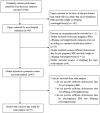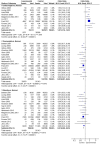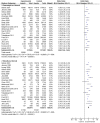Pre-pregnancy body mass index in relation to infant birth weight and offspring overweight/obesity: a systematic review and meta-analysis
- PMID: 23613888
- PMCID: PMC3628788
- DOI: 10.1371/journal.pone.0061627
Pre-pregnancy body mass index in relation to infant birth weight and offspring overweight/obesity: a systematic review and meta-analysis
Abstract
Background: Overweight/obesity in women of childbearing age is a serious public-health problem. In China, the incidence of maternal overweight/obesity has been increasing. However, there is not a meta-analysis to determine if pre-pregnancy body mass index (BMI) is related to infant birth weight (BW) and offspring overweight/obesity.
Methods: Three electronic bibliographic databases (MEDLINE, EMBASE and CINAHL) were searched systematically from January 1970 to November 2012. The dichotomous data on pre-pregnancy overweight/obesity and BW or offspring overweight/obesity were extracted. Summary statistics (odds ratios, ORs) were used by Review Manager, version 5.1.7.
Results: After screening 665 citations from three electronic databases, we included 45 studies (most of high or medium quality). Compared with normal-weight mothers, pre-pregnancy underweight increased the risk of small for gestational age (SGA) (odds ratios [OR], 1.81; 95% confidence interval [CI], 1.76-1.87); low BW (OR, 1.47; 95% CI, 1.27-1.71). Pre-pregnancy overweight/obesity increased the risk of being large for gestational age (LGA) (OR, 1.53; 95% CI, 1.44-1.63; and OR, 2.08; 95% CI; 1.95-2.23), high BW (OR, 1.53; 95% CI, 1.44-1.63; and OR, 2.00; 95% CI; 1.84-2.18), macrosomia (OR, 1.67; 95% CI, 1.42-1.97; and OR, 3.23; 95% CI, 2.39-4.37), and subsequent offspring overweight/obesity (OR, 1.95; 95% CI, 1.77-2.13; and OR, 3.06; 95% CI, 2.68-3.49), respectively. Sensitivity analyses revealed that sample size, study method, quality grade of study, source of pre-pregnancy BMI or BW had a strong impact on the association between pre-pregnancy obesity and LGA. No significant evidence of publication bias was observed.
Conclusions: Pre-pregnancy underweight increases the risk of SGA and LBW; pre-pregnancy overweight/obesity increases the risk of LGA, HBW, macrosomia, and subsequent offspring overweight/obesity. A potential effect modification by maternal age, ethnicity, gestational weight gain, as well as the role of gestational diseases should be addressed in future studies.
Conflict of interest statement
Figures




Comment in
-
Authors' reply re: Associations of maternal prepregnancy body mass index and gestational weight gain with cardio-metabolic risk factors in adolescent offspring: a prospective cohort study.BJOG. 2016 Nov;123(12):2054-2055. doi: 10.1111/1471-0528.14285. BJOG. 2016. PMID: 27753251 No abstract available.
References
-
- Li XY, Jiang Y, Hu N, Li YC, Zhang M, et al. (2012) [Prevalence and characteristic of overweight and obesity among adults in China, 2010]. Zhonghua Yu Fang Yi Xue Za Zhi 46: 683–686. - PubMed
-
- Ge K (1995) Dietary and Nutritional Status of Chinese people in 90th: report of China National Nutrition Survey of 1992. Beijing: People's Medical Publishing House.
-
- Heslehurst N, Rankin J, Wilkinson JR, Summerbell CD (2010) A nationally representative study of maternal obesity in England, UK: trends in incidence and demographic inequalities in 619 323 births, 1989–2007. Int J Obes (Lond) 34: 420–428. - PubMed
-
- Kim SY, Dietz PM, England L, Morrow B, Callaghan WM (2007) Trends in pre-pregnancy obesity in nine states, 1993–2003. Obesity (Silver Spring) 15: 986–993. - PubMed
-
- Hinkle SN, Sharma AJ, Kim SY, Park S, Dalenius K, et al. (2012) Prepregnancy obesity trends among low-income women, United States, 1999–2008. Matern Child Health J 16: 1339–1348. - PubMed
Publication types
MeSH terms
LinkOut - more resources
Full Text Sources
Other Literature Sources
Medical

